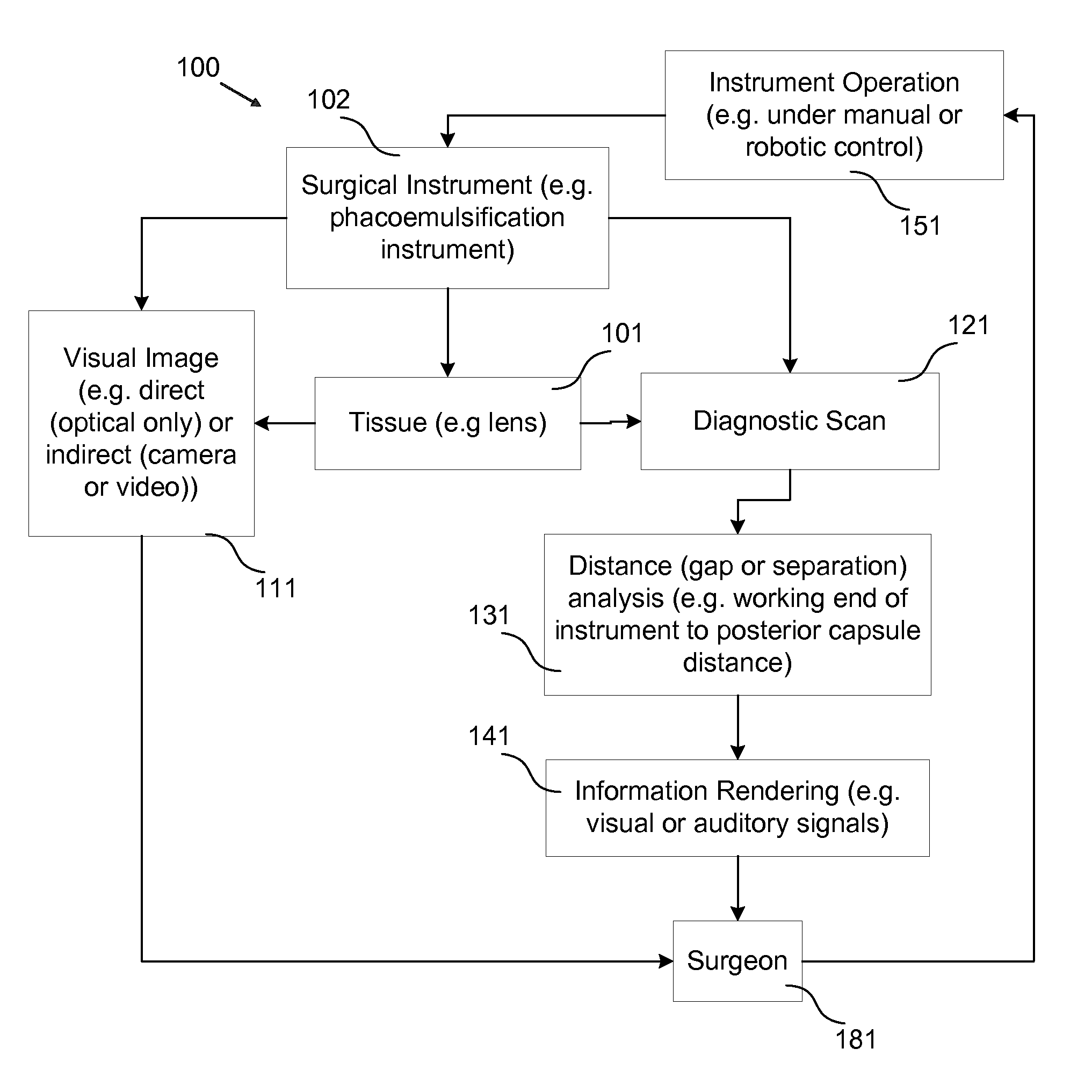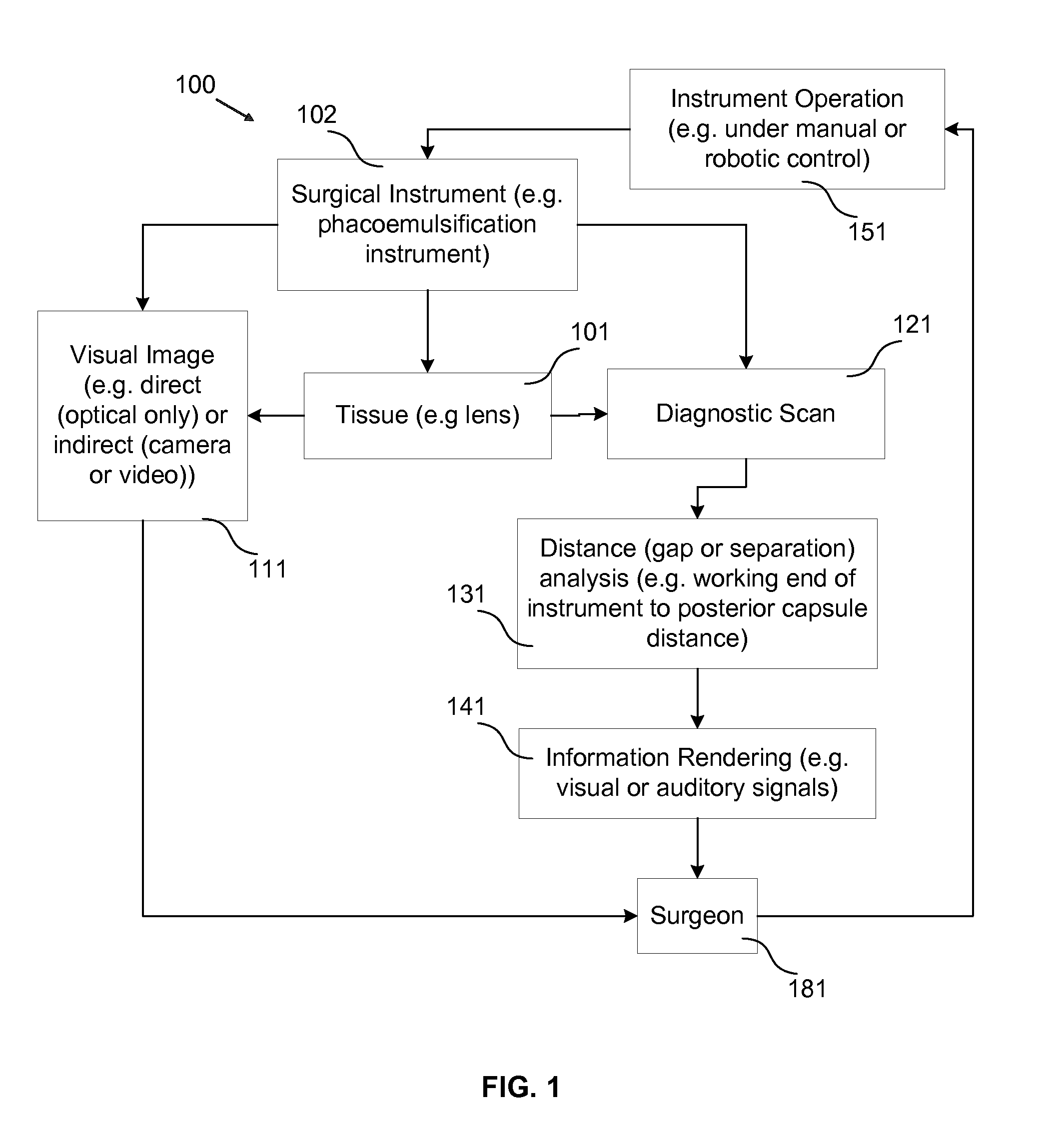Surgical Procedures Using Instrument to Boundary Spacing Information Extracted from Real-Time Diagnostic Scan Data
a technology of real-time diagnostic scan data and surgical procedures, applied in the field of surgical procedures, can solve the problems of failure to meet the surgical goal, inadequate removal of healthy tissue, and excess removal of healthy tissue, and achieve the effect of less risk for patients
- Summary
- Abstract
- Description
- Claims
- Application Information
AI Technical Summary
Benefits of technology
Problems solved by technology
Method used
Image
Examples
first embodiment
[0047]Variations of the first embodiment may obtain scan data form a variety sources and may obtain that data in a variety of forms. For example FIG. 2A provides several alternative types of diagnostic scans 121 that may be performed during a given surgery. In different types of surgeries different types of scans may be preferred due to different abilities to distinguish different tissue types, different resolutions available, different scanning speeds, different scanning logistics that are applicability to different surgical circumstances, and the like. In particular, FIG. 2A indicates for example scan types that the used: an OCT scan 121-1, an MRI scan 121-2, a UBM scan 121-3, and / or an ultrasonic scan 121-4. It is understood by those of skill in the art that other scan types may also be used in some alternative embodiments.
[0048]Variations of the first embodiment may provide and / or render distance, information into a variety of forms. FIG. 2B provides two examples of alternative ...
second embodiment
[0055]FIG. 3 provides a block diagram representing selected steps of the invention that is similar to the first embodiment of the invention with the exception that rendered information takes the form of a visual representation that is overlaid with real visual images that are presented to the surgeon.
[0056]Like elements between FIGS. 1 and 3 are labeled with like reference numerals with the exception that the elements of FIG. 3 use the 200 series while elements in FIG. 1 used the 100 series. Element 241 calls for the rendering to be in visual form which is combined with the visual image 211 of the surgical instrument 202 and tissue 201 before presentation to the surgeon. The combining or overlaying of these visual images may occur optically as described in incorporated U.S. patent application Ser. No. 13 / 164,671 or electronically while the images remain in a data form. The overlaying may occur using markerless tracking algorithms with or without electronic or optical feedback allowi...
third embodiment
[0057]FIG. 4 provides a block diagram representing selected steps of the invention that is similar to the second embodiment of the invention with the exception that in addition to the diagnostic scan data being used to provide distance information concerning the separation of a working end of the instrument and the posterior surface, the diagnostic scan data is also used to provide information concerning remaining thickness of material that is located between the working end of the instrument and the posterior surface, which thickness may be less than the distance when some of the intervening material has already been removed, visual information associated with the distance and thickness is then combined with the visual image of the instrument and tissue for presentation to the surgeon.
[0058]As with FIG. 3 like elements between FIGS. 4 and 3 are identified with like reference numerals with the exception that the reference numerals of FIG. 4 are presented in the 300 series as opposed...
PUM
 Login to View More
Login to View More Abstract
Description
Claims
Application Information
 Login to View More
Login to View More - R&D
- Intellectual Property
- Life Sciences
- Materials
- Tech Scout
- Unparalleled Data Quality
- Higher Quality Content
- 60% Fewer Hallucinations
Browse by: Latest US Patents, China's latest patents, Technical Efficacy Thesaurus, Application Domain, Technology Topic, Popular Technical Reports.
© 2025 PatSnap. All rights reserved.Legal|Privacy policy|Modern Slavery Act Transparency Statement|Sitemap|About US| Contact US: help@patsnap.com



